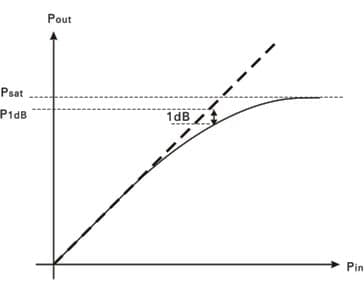What is the 1 dB compression point or P1dB?

P1dB
The 1dB compression point (P1dB) is a key parameter in RF and microwave systems, defining the input power level where a device’s gain drops by 1dB due to non-linearity. This metric is crucial for assessing amplifier performance, ensuring optimal signal integrity in communication systems.
When operating within the linear region of a component(such as power amplifier, mixer, etc.), gain through that component is constant for a given frequency. An amplifier usually provides a constant gain over a specific frequency range. If we represent the Input power Vs Output power of an amplifier on a graph, we get a straight line (Linear Relationship). i.e.
Output Power = Input Power + Gain
As the input power level increases, there comes a point where the output power of the amplifier no longer increases by the gain value i.e the amplifier output power starts to saturate. Before saturation, a point is reached where the power of the signal at the output is not amplified by the same amount as the smaller signal rather we get a compressed output.
The 1 dB compression point (P1dB) is the output power level at which the gain decreases 1 dB from its constant value. i.e.
OP1dB (dBm) = IP1dB (dBm) + Small Signal Gain (dB) - 1 dB

Gain compression occurs because eventually the output signal (voltage, current, power) limits, due to the supply voltage or bias current.
Once an amplifier reaches its P1dB it goes into compression and becomes a non-linear device, producing distortion, harmonics, and intermodulation products. Amplifiers should always be operated below the compression point.



